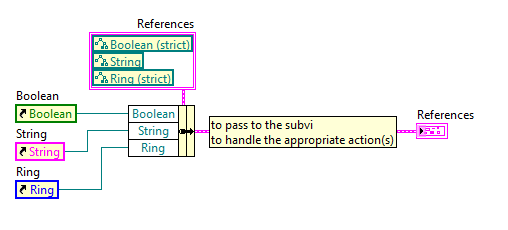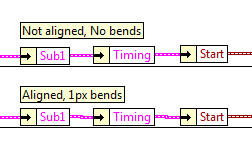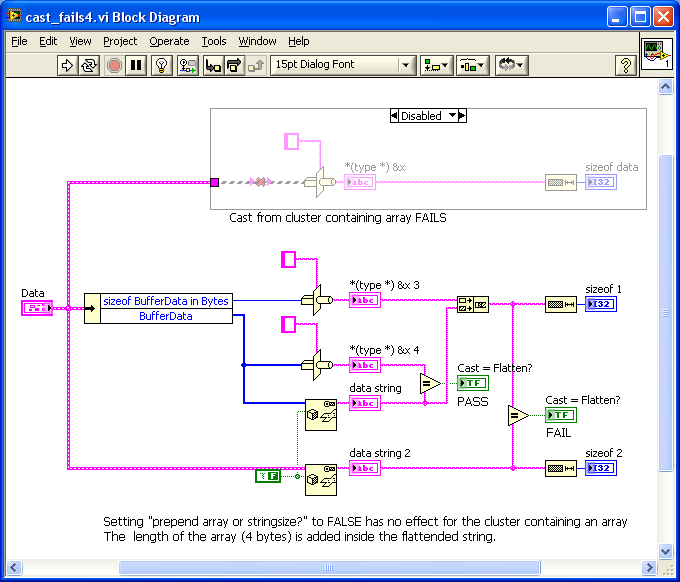
tnt
-
Posts
86 -
Joined
-
Last visited
-
Days Won
1
Content Type
Profiles
Forums
Downloads
Gallery
Posts posted by tnt
-
-
Please post your question only once and not 7 times in multiple groups...
-
Since it seems like no one bothered to update this thread... the event structure timeout behavior for registered-but-not-cased events has been modified per user requests. Check page 16 of the LV 2013 upgrade notes.
On page 16 you can find "Viewing Enqueued Events at Run Time" which is a nice feature.
You wanted to refer to page 11: "Changes to the Behavior of the Event Structure Timeout Terminal for Non-Handled, Dynamically Registered Events"
--> In LabVIEW 2013, non-handled, dynamically registered events do not reset the Event structure timeout terminal.
-
This is still not the borderless one posted by AQ years ago. This is also a 1px border. If you put a numeric in the cluster then the cluster in an array, the size of the array will be 2 pixels larger in width and height when compared to just an array of the numeric. The cluster I posted will be 1 pixel larger in height and width. The one originally posted would be the exact same size because it was truly borerless.
I had found the same 1px border in my 2009 archive and I can't remember seeing a 0px border before. (related post: http://lavag.org/topic/11002-cluster-border-thickness/)
Set Autosizing to "None" and make it the same size as the numeric, align the numeric in the center and you won't see a difference anymore.
-
Hi,
you did not clearly mention if you got it to work or not. If you pass the proper references to your last example, it should work.
Edit: I forgot to check the other thread first:
11-08-201306:46 AMThis way it works, but is it correct way of programming?
When doing it the way I proposed in my previous post, you don't need the "to more specific class" because all references keep their original type
(while in your example the build array reverts the types to the lowest common type)(I don't have LV 2012 installed so I can't quickly test your snippets)
-
 1
1
-
-
Hi,
I guess you are getting the error because you have connected the constants (unfilled cluster) directly to the subvi.
You need to use the "Bundle By Name" to fill the cluster with the references of the controls.
-
 1
1
-
-
It's not wrong. The two forums share alot of the same knowledge but sometimes someone at NI's forums may have an idea that someone here did not. When making a post that you want to involve both communities in, generally people will have a link to the same post on the other forum, so that anyone can get a more complete picture of the things you've tried, and suggestions others have made.
The main goal for mentioning you cross-posted in another thread/forum is to prevent
that someone takes the time to answer your question here, while it may already been answered in the other thread/forum.
-
 1
1
-
-
When inserting an 'Unbundle By Name' I always seem to move the wire 1px down to remove the bend.
(... and hiding the 1 px bend
 )
)For some reason the input and output are not aligned.
The unbundle is 18px, the center of the 3px error cluster wire on the left
is located 1px below the 1px output wire on the right.
Same issue when having multiple sequential Unbundles...
* I know this can be done in 1 single unbundle, but when you reuse clusters inside another big configurationcluster
the unbundles can get corrupted (linked to the first possible match) when updating the source cluster.
(Maybe this bug has been solved or not, but I still unbundle first when I know there are identical names inside) -
The last few weeks there is a lot of spam from "new" users/bots (e.g. > 10 new topis within 1 hour)
For some reason I find the new spam topics much more annoyant when compared to a single spam message as a reply inside a topic.
Can the number of new topics a user can start to be limited to e.g. 1 or 2 a day?
(Also prevents new/novice users to post the same question in multiple categories)I also remember a topic where someone proposed for adding a kind of LabVIEW Captcha
with a simple CLAD-question to prove the new user has a basic knowledge.
... just my thoughts ...
-
Hi,
see ftp://ftp.ni.com/evaluation/labview/ekit/other/downloader/
and just search for "LV2009SP1"
(You're lucky, I could only find LV2009 and newer)-
 1
1
-
-
Nice...
Have you noticed the date ????
-
Hi,
for each Tab page you can set the Tabbing order
by right-clicking on the Tab label (or Tab border) and select "Reorder Controls In Page...".
-
Hi Guys,
almost 2 years ago I have build a rotate which included the rotation of transparant images.
After reading the 'image data' from a (png-)file you get a 24-bit image together with the mask containing the transparency information
 .
.See the attached vi (LV 8.5.1)
Rotate Transparent Image (24bit).vi
I think this contains everything you (and hopefully also others) need to do get this done in pure G.
Good luck...
-
Hi Mr Mike,
in Belgium we also have the same plugs and the only thing I can tell is that this is not standardized.
One place live is left, other place live is right...
This socket also allows ungrounded plugs which can swap left and right.
It is AC so this shouldn't be a problem.
-
Anybody verified this with Windows XP system. Any changes need to be made to an XP machine to make it work?
Verifying the Domain credentials worked for me on Windows XP, just make sure the domain name is filled in correctly.
-
HI,
could you upload a 2010 VI or a screenshot?
I don't have 2011 installed yet.
-
-
 1
1
-
-
To divert a little here: are you sure you need to do this? In my experience, when calling DLLs that have a BufferData input array and a sizeofBufferData input numeric, all you need to do is put your byte array into BufferData, and put the number of elements of BufferData into sizeofBufferData (note: your BufferData array in the cluster is an array of I32 - my guess is that they're bytes so they should be U8).
I cannot do much about the way the data is expected, I have to pass some kind of header followed by the BufferData and this all packed together as an array of bytes.
The example was just a stripped down version, the BufferData itself is in fact an array of structures containing different types of data.
I was just looking for an easy way to convert the header and the data to U8[]
without having to go manually through all elements (header and buffer) for converting to U8 and pasting it together.
-
-
Link doesnt work for me?
It worked for me, I got access to the download by manually copying the link from the mail I received.
(clicking on it failed because of invalid hyperlinks)
-
Hi,
I need to pass some data to a DLL and need to pass the number of bytes I'm passing also.
I tried using 'cast' (should accept anything) for getting the memmap but this fails (polymorphic input cannot accept this datatype) due to an array inside the cluster.
Then I wanted to switch to 'flatten to string' for getting the same result and now the arraysize is prepended before the arraydata
I stripped down the code to the bare parts but I don't want to unbundle all elements from my original cluster, just for getting the size.
Attached you can find a LV8.5 version, the behaviour in LV 2010 SP1 is exactly the same.
thx
tnt
-
Hi,
a while back I had some similar issues.
I just did a small test om my dualcore XP 32-bit LV8.5.1 with 4 GB RAM and had no problems allocating and using a 5000x5000 SGL (4-bytes)-array,
when switching the datatype to DBL I got "memory full" / "not enough memory to complete this operation".
Other solutions that helped in my particular case was using the XP /3GB switch in boot.ini which allows for larger memoryblocks
and/or creating the 5000*5000 array (If possible in your case) as an array of 5000 clusters with a 5000-elements 1D-array
which does not require a big area of continuous free memory (in my case a 8000 pixels linscan camera) but 5000 times 5000 elements.
Also be aware of memcopies of your data when displaying in indicators...
Good luck...
-
I started the implementation of 8B/10B encoding in LabVIEW (decoding will be done later)
with a simple LUT but - when I reached special cases like D.x.P7 and D.x.A7 -
I wondered if someone already did this before (and wants to share his/her experience).
http://en.wikipedia.org/wiki/8B/10B
I searched for examples but found none that were easy to convert to labview or
were easy to call from inside LabVIEW.
-
Hi Thomas,
just press "Join group" and (normally) NI will grant you access so you can see all documents.
TNT
-
I think It's in Omar's slide deck from niweek:
Thanks, looks like I've visited also other websites

Found it:
Thanks, even easier






Strange delays in loading LabVIEW Vi that call .NET
in Calling External Code
Posted · Edited by tnt
Hi,
we had a similar problem as well, network connection: fast start, no network: very slow
--> see http://digital.ni.com/public.nsf/allkb/9A7E2F34EC9DDEDE86257A09002A9E14 (different article)
We used the workaround with the application configurationfile placed next to the executable (=same solution as LogMAN)
because it is a very easy fix, requires zero to less additional documentation in case of a reinstall
and does not need any changes to the Internet options (or regedit, or gpedit).
(This apparantly resulted in an even faster startup of the application compared to altering the Internet options)
You can create an application configuration file:
1. Open Notepad and paste in the code below:
2. Save the file in the directory of the application with the name: <ApplicationName>.exe.config
3. Run the application, and the config file should disable the CLR check for the application.